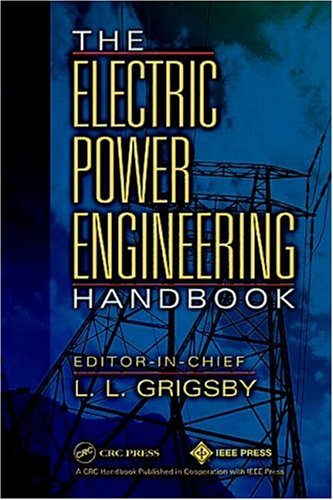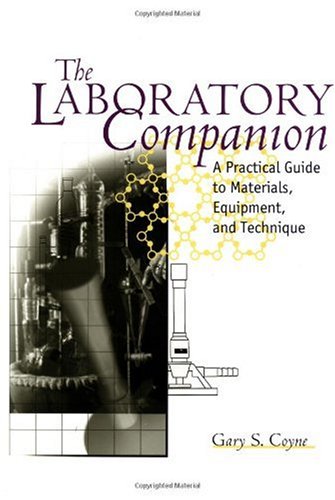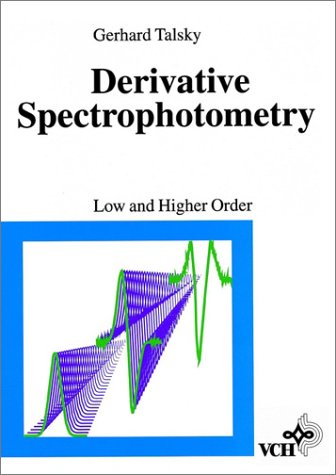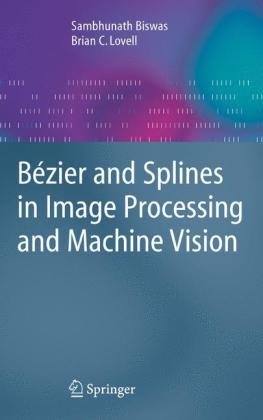Leonard L. Grigsby0849385784, 9780849385780
Table of contents :
The Electric Power Engineering Handbook……Page 2
The Electrical Engineering Handbook Series……Page 3
Preface……Page 6
Editor-in-Chief……Page 7
Editorial Board……Page 8
Contributors……Page 9
Table of Contents……Page 14
1 Electric Power Generation: Non-Conventional Methods……Page 19
Table of Contents……Page 0
1.1 Wind Power……Page 20
Applications……Page 21
Large, Grid Connected……Page 22
Wind Variability……Page 23
Storage Systems……Page 26
Superconducting Magnetic Energy Storage……Page 27
Battery Storage……Page 28
Fuel Cells……Page 29
Fuel Cell Operation……Page 30
Summary……Page 32
Silicon Cells……Page 33
Copper Indium (Gallium) Diselenide Cells……Page 34
Emerging Technologies……Page 35
Utility-Interactive PV systems……Page 36
Stand-Alone PV Systems……Page 37
References……Page 40
2 Electric Power Generation: Conventional Methods……Page 42
2.1 Hydroelectric Power Generation……Page 43
Hydroelectric Plant Features……Page 44
Generator……Page 46
Generator Step-Up Transformer……Page 49
Governor System……Page 50
Control Systems……Page 51
Special Considerations Affecting Pumped Storage Plants……Page 52
Commissioning of Hydroelectric Plants……Page 53
General……Page 54
Stator……Page 55
Rotor……Page 56
Synchronous Machines, in General……Page 57
Synchronous Generator Capability……Page 58
Synchronous Motor and Condenser Starting……Page 60
2.3 Thermal Generating Plants……Page 62
Grounded……Page 63
Lighting Supply……Page 64
Low-Voltage Switchgear……Page 65
Types of Motors……Page 66
Cable……Page 67
References……Page 68
Available Technologies……Page 69
Microturbines……Page 70
Combustion Turbines……Page 72
Storage Technologies……Page 73
Interface Issues……Page 74
“Traditional Utility” Applications……Page 76
References……Page 77
3 Transformers……Page 79
3.1 Theory and Principles……Page 83
Iron or Steel Core Transformer……Page 84
Equivalent Circuit of an Iron Core Transformer……Page 85
Magnetic Circuit……Page 87
Leakage Reactance……Page 88
Short Circuit Forces……Page 89
Voltage Considerations……Page 90
3.2 Power Transformers……Page 91
Insulation Classes……Page 92
Cooling Classes……Page 93
Short Circuit Duty……Page 94
Economic Evaluation of Losses……Page 95
The Core……Page 97
The Windings……Page 98
Taps g Turns Ratio Adjustment……Page 103
Accessories……Page 105
Liquid Preservation Systems……Page 106
HighHTemperature Superconducting HTSD Transformer……Page 109
LongHDistance Power……Page 110
Oil Immersion……Page 111
The Electrical Engineering Handbook……Page 113
4 Transmission System……Page 114
4.1 Concept of Energy Transmission and Distribution……Page 115
Switchgear……Page 116
Concept of Energy Transmission and Distribution……Page 117
High-Voltage Transmission Lines……Page 119
High-Voltage DC Lines……Page 121
Distribution Lines……Page 122
Traditonal Line Design Practice……Page 126
Structure Types in Use……Page 128
Factors Affecting Structure Type Selection……Page 129
Current Deterministic Design Practice……Page 130
Reliability Level……Page 131
Improved Design Approaches……Page 133
Appendix A — General Design Criteria — Methodology……Page 134
Transmission Lines and Substations……Page 136
Electrical Stresses……Page 137
Environmental Stresses……Page 140
Mechanical Stresses……Page 142
Insulator Strings……Page 143
Nonceramic (Composite) Insulators……Page 145
Composite Suspension Insulators……Page 146
Porcelain Insulators……Page 148
Insulator Pollution……Page 149
Effects of Pollution……Page 151
Composite Insulators……Page 152
Aging of Composite Insulators……Page 153
Methods for Improving Insulator Performance……Page 154
4.4 Transmission Line Construction and Maintenance……Page 155
Tools……Page 156
Equipment……Page 157
Procedures……Page 158
Replacing Spacers……Page 159
Helicopter Method Considerations……Page 160
Typical Cable Description……Page 161
Conductor……Page 162
Insulation……Page 163
Metallic Sheath……Page 164
Cable Electrical Resistance……Page 165
Cable Capacitance……Page 166
Ungrounded and Single-Point Grounded Shields……Page 167
Multigrounded Shields……Page 168
Cross-Bonded with Transposition and Sectionalized with Transposition……Page 169
Underground Layout and Construction……Page 170
Testing, Troubleshooting, and Fault Location……Page 173
Equivalent Circuit……Page 175
Resistance……Page 177
Current-Carrying Capacity (Ampacity)……Page 179
Inductance and Inductive Reactance……Page 180
Capacitance and Capacitive Reactance……Page 188
References……Page 195
Catenary Cables……Page 202
Approximate Sag-Tension Calculations……Page 210
Numerical Sag-Tension Calculations……Page 215
5 Substations……Page 217
SF6……Page 219
Construction and Service Life……Page 220
Circuit Breaker……Page 222
Voltage Transformers……Page 223
Ground Switches……Page 224
Air Connection……Page 225
Direct Transformer Connections……Page 226
Surge Arrester……Page 227
Control System……Page 228
Gas Compartments and Zones……Page 231
Grounding……Page 232
Testing……Page 233
Economics of GIS……Page 234
5.2 Air Insulated Substations — Bus/Switching Configurations……Page 235
Main and Transfer Bus (Fig. 5.19)……Page 236
Ring Bus (Fig. 5.21)……Page 238
Breaker-and-a-Half (Fig. 5.22)……Page 239
Ambient Conditions……Page 240
Load Break Switches……Page 241
Power Fuses……Page 242
Circuit Breakers……Page 243
References……Page 245
Frequency Converters (HVDC)……Page 246
FACTS Controllers……Page 247
Control……Page 249
6 Distribution Systems……Page 253
Load Classifcation……Page 254
Modeling Applications……Page 255
Load Characteristics and Models……Page 256
Exponential Models……Page 257
Polynomial Models……Page 259
Combined Exponential and Polynomial Models……Page 260
Comparison of Exponential and Polynomial Models……Page 261
Load Window Modeling……Page 262
References……Page 263
Line Impedance……Page 264
Shunt Admittance……Page 278
Line Segment Models……Page 281
Step-Voltage Regulators……Page 285
Transformer Bank Connections……Page 295
Load Models……Page 306
Shunt Capacitor Models……Page 310
Power Flow Analysis……Page 311
Short Circuit Analysis……Page 317
Implementation of Distribution Automation……Page 320
Distribution SCADA……Page 321
Host Computer System……Page 322
Field Devices……Page 323
Tactical and Strategic Implementation Issues……Page 325
Choosing the Vendor……Page 326
Standards……Page 327
Deployment Considerations……Page 328
Support Organization……Page 329
7 Electric Power Utilization……Page 331
Single Stator Electromechanical Meter……Page 332
Blondel’s Theorem……Page 333
The Electronic Meter……Page 334
Site Diagnostic Meter……Page 335
Demand Metering……Page 336
Time of Use Metering……Page 337
Pulse Metering……Page 338
Totalized Metering……Page 340
Measuring kVA……Page 341
Defining Terms……Page 342
Basic Load Characterization……Page 343
Coincidence and Diversity……Page 344
Load Curves and Load Duration……Page 345
Composite Load Modeling……Page 347
Harmonics and Other Nonsinusoidal Loads……Page 348
Some General Perspectives……Page 349
Load Requirements……Page 351
System Data Acquisition……Page 352
Field Testing……Page 353
Standards……Page 354
Books an abridged sample……Page 355
8 Power System Analysis and Simulation……Page 357
8.1 The Per-Unit System……Page 358
Impact on Transformers……Page 361
Per-Unit Scaling Extended to Three-Phase Systems……Page 366
Per-Unit Scaling Extended to a General Three-Phase System……Page 370
8.2 Symmetrical Components for Power System Analysis……Page 371
Voltage and Current Transformation……Page 373
Impedance Transformation……Page 375
Power Calculations……Page 377
System Load Representation……Page 378
Summary of the Symmetrical Components in the General ThreeRPhase Case……Page 379
Balanced Voltages and Currents……Page 381
Balanced Power Calculations……Page 382
Balanced System Loads……Page 383
Summary of Symmetrical Components in the Balanced Case……Page 384
Power Transformers……Page 386
References……Page 390
The Power Flow Problem……Page 391
Formulation of the Bus Admittance Matrix……Page 392
Formulation of the Power Flow Equations……Page 393
Bus Classifications……Page 396
The Newton-Raphson Method……Page 397
Fast Decoupled Power Flow Solution……Page 399
References……Page 400
Simplifications in the System Model……Page 401
The Balanced Three-Phase Fault……Page 402
The Single Phase-to-Ground Fault……Page 405
The Double Phase-to-Ground Fault……Page 406
An Example Fault Study……Page 407
Balanced Three-Phase Fault……Page 408
Single Phase-to-Ground Fault……Page 409
Further Considerations……Page 414
Defining Terms……Page 416
Further Information……Page 417
9 Power System Protection……Page 419
Types of Transformer Faults……Page 420
Electrical……Page 421
Thermal……Page 423
Magnetizing Inrush AInitialb Recoveryb SympatheticZ……Page 425
Backup Protection……Page 426
Unit Systems……Page 427
Restoration……Page 428
References……Page 429
Differential Protection for Stator Faults (87G)……Page 430
Protection Against Stator Winding Ground Fault……Page 433
Loss-of-Excitation Protection (40)……Page 434
Current Imbalance (46)……Page 435
Anti-Motoring Protection (32)……Page 436
Overexcitation Protection (24)……Page 437
Overvoltage (59)……Page 438
Voltage Imbalance Protection (60)……Page 439
System Backup Protection (51V and 21)……Page 440
Out-of-Step Protection……Page 442
Abnormal Frequency Operation of Turbine-Generator……Page 443
Generator Breaker Failure……Page 445
Generator Tripping Principles……Page 446
Improvements in Protective Functions……Page 447
References……Page 448
Zones of Protection……Page 449
Primary and Backup Protection……Page 450
System ConIguration……Page 451
Inverse-Time Delay Overcurrent Relays……Page 452
Instantaneous Overcurrent Relays……Page 453
Directional Overcurrent Relays……Page 454
Reactance Relay……Page 456
Pilot Protection……Page 457
Transient Stability and Out-of-Step Protection……Page 458
Voltage Stability and Undervoltage Load Shedding……Page 460
Special Protection Schemes (SPS)……Page 461
References……Page 462
Sampling……Page 463
Antialiasing Filters……Page 464
Phasors from Samples……Page 465
Symmetrical Components……Page 468
Parameter Estimation……Page 469
Least Squares Fitting……Page 470
DFT……Page 471
Differential Equations……Page 472
Kalman Filters……Page 474
Wavelet Transforms……Page 476
Neural Networks……Page 479
References……Page 480
9.6 Use of Oscillograph Records to Analyze System Performance……Page 481
10 Power System Transients……Page 493
First Strokes……Page 495
Ground Flash Density……Page 497
Current Peak Value……Page 498
Incidence of Lightning to Power Lines……Page 499
References……Page 500
10.2 Overvoltages Caused by Direct Lightning Strokes……Page 501
Direct Strokes to Unshielded Lines……Page 502
Direct Strokes to Shielded Lines……Page 504
Shielding Design……Page 506
Significant Parameters……Page 509
Unshielded Lines……Page 510
References……Page 513
10.3 Overvoltages Caused by Indirect Lightning Strokes……Page 514
Inducing Voltage……Page 515
Induced Voltage……Page 516
Green’s Function……Page 517
Evaluation of Green’s Function……Page 518
Induced Voltage Caused by Return-Stroke Current of Arbitrary Waveshape……Page 519
Induced Voltages on Multiconductor Lines……Page 522
Effects of Shield Wires on Induced Voltages……Page 523
Estimation of Outage Rates Caused by Nearby Lightning Strokes……Page 524
References……Page 527
Appendix I: Voltage Induced by Linearly Rising and Falling Return- Stroke Current……Page 528
Transmission Line Switching Operations……Page 529
Series Capacitor Bank Applications……Page 532
Shunt Reactor Applications……Page 533
10.5 Very Fast Transients……Page 534
Origin of VFT in GIS……Page 535
Internal Transients……Page 536
External Transients……Page 537
Modeling Guidelines and Simulation……Page 539
Computation of Internal Transients……Page 540
Computation of TEV……Page 541
Statistical Calculation……Page 543
Effects of VFT on Equipment……Page 544
References……Page 546
Sources and Types of Transient Voltage Excitation……Page 547
Complex Issue to Predict……Page 548
Initial Voltage Distribution……Page 549
Transient Voltage Distribution……Page 550
History……Page 551
Lumped Parameter Model……Page 552
Solution in the Time Domain……Page 553
Definitions……Page 554
Impedance vs. Frequency……Page 555
Definition of Inductance……Page 556
Transformer Inductance Model……Page 558
Definition of Capacitance……Page 559
Equivalent Capacitance for Disk Windings……Page 560
Copper Losses……Page 562
Core Losses……Page 564
Design……Page 565
Shell—Form……Page 566
Standard Winding Tests……Page 567
Design Margin……Page 568
Reduced Order Model……Page 570
References……Page 571
General Concepts……Page 573
Material Properties……Page 574
Electrode Dimensions……Page 575
Initial Transient Response from Capacitance……Page 576
Ground Electrode Impedance over Perfect Ground……Page 577
Analytical Treatment of Complex Electrode Shapes……Page 578
Numerical Treatment of Complex Electrode Shapes……Page 579
Treatment of Multilayer Soil Effects……Page 580
Layer of Finite Thickness over Insulator……Page 581
Design Recommendations……Page 582
References……Page 583
Appendix A: Relevant IEEE Grounding Standards……Page 584
Probability of Flashover ApfoR……Page 586
Multiple Gaps and Multiple Phases……Page 587
Voltage Waveshape……Page 588
Effect of Insulator……Page 589
Effect of Atmospheric Conditions on Air Insulation……Page 590
Example:……Page 591
Application of Surge Arresters……Page 592
Examples of Surge Arrester Application (Non-Self-restoring Insulation)……Page 594
References……Page 595
The Electric Power Engineering Handbook……Page 598
11 Power System Dynamics and Stability……Page 599
Basic Concepts……Page 600
Rotor Angle Stability……Page 601
Voltage Stability……Page 603
Frequency Stability……Page 604
Historical Review of Stability Problems……Page 605
Consideration of Stability in System Design and Operation……Page 606
References……Page 607
11.2 Transient Stability……Page 608
The Swing Equation……Page 609
The PowerMAngle Relationship……Page 610
The Equal Area Criterion……Page 611
Modeling……Page 613
Analytical Methods……Page 614
Transient Stability Considerations in System Design……Page 616
Historical Perspective……Page 618
Power System Oscillations Classiged by Interaction Characteristics……Page 621
Conceptual Description of Power System Oscillations……Page 622
Summary on the Nature of Power System Oscillations……Page 623
Criteria for Damping……Page 624
Study Procedure……Page 625
Control Objectives……Page 626
Input Signal Selection……Page 627
Control Algorithm……Page 628
Adverse Side Effects……Page 629
Summary……Page 630
References……Page 631
Generic Dynamic LoadMVoltage Characteristics……Page 632
Load Flow Analysis……Page 634
Voltage Stability as Affected by Load Dynamics……Page 636
Mitigation of Voltage Stability Problems……Page 638
11.5 Direct Stability Methods……Page 640
Review of Literature on Direct Methods……Page 641
The Power System Model……Page 643
Review of Stability Theory……Page 644
The Transient Energy Function……Page 646
Determination of the Controlling UEP……Page 648
The BCU LBoundary Controlling UEPT Method……Page 649
References……Page 650
Review of Power System Synchronous Stability Basics……Page 653
Concepts of Power System Stability Controls……Page 656
Feedforward Controls……Page 657
Actuators……Page 658
Excitation Control……Page 659
Generator Tripping……Page 660
Fast Fault Clearing, High Speed Reclosing, and Single-Pole Switching……Page 661
Load Tripping and Modulation……Page 662
Reactive Power Compensation Switching or Modulation……Page 663
Fast Voltage Phase Angle Control……Page 664
Dynamic Security Assessment……Page 665
Experience from Recent Power Failures……Page 666
References……Page 667
Modeling Requirements……Page 670
Rotor Mechanical Model……Page 671
Generator Electrical Model……Page 672
Saturation Modeling……Page 673
Prime Mover Modeling……Page 674
Load Modeling……Page 676
Dynamic Equivalents……Page 678
References……Page 679
Dynamic Information Needs: The WSCC Breakup of August 10, 1996……Page 680
Background……Page 681
Direct Sources of Dynamic Information……Page 682
Monitor System Functionalities……Page 683
Event Detection Logic……Page 684
Monitor Architectures……Page 685
Monitor Network Topologies……Page 688
Networks of Networks……Page 693
WSCC Experience in Monitor Operations……Page 696
12 Power System Operation and Control……Page 699
12.1 Energy Management……Page 700
Power System Data Acquisition and Control……Page 701
Load Frequency Control……Page 703
Interchange Transaction Scheduling……Page 704
Energy Management……Page 705
Security Control……Page 706
Energy Control System……Page 707
References……Page 708
Economic Dispatch Depned……Page 709
EDC and System Limitations……Page 710
The Traditional EDC Mathematical Formulation……Page 711
EDC Solution Techniques……Page 712
An Example of Cost Minimizing EDC……Page 713
Unit Commitment Depned……Page 714
Factors to Consider in Solving the UC Problem……Page 715
Mathematical Formulation for UC……Page 716
The Importance of EDC to the UC Solution……Page 718
A GeneticxBased UC Algorithm……Page 719
Summary of Economical Generation Operation……Page 725
12.3 State Estimation……Page 726
Measurement Representations……Page 727
Solution Methods……Page 729
Network Topology Assessment……Page 732
Error Identixcation……Page 733
WLS State Estimation Process……Page 734
Defining Terms……Page 736
12.4 Optimal Power Flow……Page 737
Conventional Optimal Economic Scheduling……Page 738
Conventional OPF Formulation……Page 739
Application of Optimization Methods to OPF……Page 740
Conventional OPF Studies Including Load Models……Page 743
Security Constrained OPF Including Load Models……Page 744
SCOPF Including Load Modeling……Page 745
Operational Requirements for Online Implementation……Page 746
Discrete Modeling……Page 747
Detecting and Handling Infeasibility……Page 748
OPF-Based Transmission Service Pricing……Page 749
References……Page 750
12.5 Security Analysis……Page 752
Time Frames for Security-Related Decision (McCaulley et al., 1999)……Page 753
Models……Page 754
Standards……Page 756
Appendix B……Page 757
References……Page 758
13 Power System Planning (Reliability)……Page 760
13.1 Planning……Page 761
Defining a Competitive Framework……Page 762
Present View of Overall Problem……Page 763
Market Structure……Page 765
Fully Evolved Marketplace……Page 766
Computerized Auction Market Structure……Page 769
Capacity Expansion Problem Definition……Page 770
References……Page 772
Artificial Neural Networks……Page 776
Error BackNPropagation Learning Rule……Page 777
Short-Term Load Forecasting……Page 778
ANNSTLF Architecture……Page 779
Holidays and Special Days……Page 780
Performance……Page 782
Short-Term Price Forecasting……Page 783
Performance……Page 784
References……Page 785
Bulk Power System Reliability and Supply Point Reliability……Page 786
Reliability Criteria……Page 787
Reliability Criteria……Page 788
Reliability Measures – Reliability Indices……Page 789
Cost of Interruptions to Consumers……Page 790
Outage Models……Page 791
Contingency Enumeration Approach……Page 793
Comparison of Contingency Enumeration and Monte Carlo Simulation……Page 794
Application Examples……Page 795
Local Area Reliability……Page 796
References……Page 799
13.4 Power System Planning……Page 800
Arenas……Page 801
Options……Page 802
Uncertainties……Page 803
Attributes……Page 806
Setting Standards or Criteria……Page 807
LeastNCost Planning……Page 808
Making Choices……Page 809
13.5 Power System Reliability……Page 811
System Adequacy Assessment……Page 812
System Security Assessment……Page 814
Distribution System Reliability……Page 816
Typical Sequence of Events after an Overhead Distribution Fault……Page 817
Distribution Reliability Indices……Page 818
Storms and Major Events……Page 819
Component Reliability Data……Page 820
Transformer Failures……Page 821
Tree Contact……Page 822
Mice, Rats, and Gophers……Page 823
Annual Variations in Reliability……Page 824
References……Page 825
14 Power Electronics……Page 827
Thyristor and Triac……Page 828
Gate Turn-Off Thyristor (GTO)……Page 829
Power Transistor……Page 831
Power MOSFET……Page 832
MOS-Controlled Thyristor (MCT)……Page 833
Uncontrolled Rectifiers……Page 835
Mechanics of Diode Conduction……Page 836
Single-Phase Half-Wave Rectifier Circuits……Page 837
Full Wave Rectifiers……Page 840
Three-Phase Recti.ers (Half-Wave and Full-Wave)……Page 844
Influence of Three-Phase Rectification on the Power System……Page 846
Controlled Rectifiers……Page 852
Single-Phase H-bridge Recti.er Circuits with Thyristors……Page 855
Average Output Voltage……Page 860
HVDC Transmission Systems……Page 861
Power System Interaction with Three-phase Thyristor AC to DC Rectifier Systems……Page 862
14.3 Inverters……Page 864
Single Phase Inverters……Page 865
Three Phase Inverters……Page 867
Multilevel Inverters……Page 869
Line Commutated Inverters……Page 870
14.4 Active Filters for Power Conditioning……Page 871
Harmonic Current Sources and Harmonic Voltage Sources……Page 872
The Akagi-Nabae Theory……Page 874
Energy Storage Capacity……Page 876
Classification by System ConVguration……Page 877
Classification by Control Strategy……Page 880
System Configuration……Page 881
Operating Principle……Page 882
Control Circuit……Page 883
Experimental Results……Page 884
Present Status and Future Trends……Page 885
Shunt Active Filters for Three-Phase Four-Wire Systems……Page 886
The 48-MVA Shunt Active Filter for Compensation of Voltage Impact Drop,
Variation,and Imbalance……Page 887
Acknowledgment……Page 888
References……Page 889
15 Power Quality……Page 892
15.1 Introduction……Page 893
The National Electric Code……Page 894
NEC Definitions:……Page 895
Personal Safety……Page 896
Noise Control……Page 897
Typical Wiring and Grounding Problems……Page 898
Insulated Grounds……Page 899
Missing Safety Ground……Page 900
Additional Ground Rods……Page 901
InsufNcient Neutral Conductor……Page 902
Case Study……Page 904
Case Study — Flickering Lights……Page 905
15.3 Harmonics in Power Systems……Page 908
15.4 Voltage Sags……Page 916
Voltage Sag Magnitude – Monitoring……Page 917
Origin of Voltage Sags……Page 918
Voltage Sag Magnitude N Calculation……Page 919
Propagation of Voltage Sags……Page 920
Critical Distance……Page 921
PhaseOAngle Jumps……Page 922
ThreeOPhase Unbalance……Page 923
Voltage Tolerance Requirement……Page 924
Single-Phase Rectifiers……Page 925
From Fault to Trip……Page 928
Changing the Power System……Page 930
Different Events and Mitigation Methods……Page 931
References……Page 932
Further Information……Page 933
15.5 Voltage Fluctuations and Lamp Flicker in Power Systems……Page 934
15.6 Power Quality Monitoring……Page 941
Selecting a Monitor……Page 942
Voltage……Page 943
Current Recordings……Page 946
Current Waveshape Disturbances……Page 947
Summary……Page 948







Reviews
There are no reviews yet.